Country Joe and the Fish | ||
| Allmusic Biography : If you mention the name Country Joe & the Fish to Americans born before 1955, chances are that theyll know the band youre talking about, at least to the degree that they know their most widely played and quoted song, "I Feel Like Im Fixin to Die Rag." The problem is, that particular song captured only the smallest sliver of who Country Joe & the Fish were and what they were about. One of the original and most popular of the San Francisco Bay Area psychedelic bands, they were also probably the most enigmatic. Joe McDonald may have written the most in-your-face anti-war, anti-military song to come out of the 60s, but he was also one of the very few musicians on the San Francisco scene whod served in uniform. Born on January 1, 1942 to a leftist-oriented family, McDonald was named in honor of Soviet leader Joseph Stalin. (In the context of World War II, Stalin was regarded by many on the left -- and even some apolitical observers in the United States and elsewhere -- as heroic, for being Hitler and Nazi Germanys greatest nemesis at a time when the governments of England, France, and the United States were waffling and dithering over what to do about German militarism). McDonald was raised in the Los Angeles suburb of El Monte, where he grew up surrounded by all manner of political activity in support of labor unions and other leftist and progressive causes. He was also exposed to a massive amount of music, ranging from R&B; to Dixieland jazz. His own early gigs were as a trombonist in jazz outfits and a guitarist in folk groups. He spent most of the early 60s serving in the Navy, in which he enlisted at age 18. On returning to civilian life in 1964, McDonald resumed playing music and cut his first album in collaboration with Blair Hardman in 1964, titled The Goodbye Blues; hed also started editing a radical magazine called Et Tu. Soon after, McDonald headed for Berkeley, California -- his official purpose was to attend college, but he quickly became a part of the citys burgeoning folk music scene. He mostly worked solo, playing songs by Pete Seeger, Lee Hays, and Woody Guthrie interspersed with some of his own compositions, and was devoted to politics. Vietnam wasnt yet a central issue, but civil rights, the economic embargo of Cuba, the working conditions of migrant farm laborers, Americas role in decades of repressive politics of the Dominican Republic, and a Kennedy-era foreign policy initiative called Food for Peace were all on the agenda. McDonald was a natural fit, and after some solo performances he formed two groups: one called the Berkeley String Quartet in conjunction with Bob Cooper on 12-string, Tom Lightjheiser on bass, and Carl Shrager playing washboard and doubling on guitar; and the other the Instant Action Jug Band. The latter, by its very nature, had a floating membership of as many as a dozen musicians, not all of whom would necessarily appear at every gig -- they were sort of like musical minutemen of the left, intended to show up on a moments notice at whatever rally or street demonstration might be announced, on or off the campus. The jug bands ranks included Barry Melton, a prodigiously talented Brooklyn-born, Los Angeles-raised guitarist and singer who, in his mid-teens, had already amassed some serious performing credits at venues such as The Ash Grove before his family moved to Berkeley. Out of their contact and the Instant Action Jug Band grew Country Joe & the Fish, initially as a recording alias. Among McDonalds other activities in 1965, he was publishing a radical journal called Rag Baby. Accounts vary as to how the music side of Rag Baby came about -- some say that McDonald found himself with more music than articles on hand and decided to put out a "talking issue" of the magazine; other accounts say that he saw the need for the music to help support the journal and the cause, and thought he could sell copies of their records at demonstrations. Assuming the latter is true, it would make Country Joe & the Fish among the very first -- if not the first -- music act to use self-produced records to promote themselves directly. Hed already cut an album independently and knew a little bit about getting records made and pressed, and the result was the Rag Baby EP, with four songs, two by Country Joe & the Fish and two by a singer named Peter Krug, which saw the light of day in October of 1965. That lineup for Country Joe & the Fish, in addition to McDonald on harmonica, acoustic guitar, and vocals, included Melton on vocals and electric guitar, plus Shrager on washboard and kazoo, Bill Steele on washtub bass, and Mike Beardslee on vocals. The bands name, Country Joe & the Fish, was a compromise proposed by ED Denson, an early member and the groups manager. He quoted Chinese communist leader Mao Zedongs metaphor about a revolutionary who resembled "the fish who swim in the sea of the people." There was also some thought given to the name "Country Mao & the Fish." Instead, they used "Country Joe" as a reference to McDonald, who was their singer and, as much as there was any organization to it at all, the organizer of the group, and also a reference to Joseph Stalin -- "Country Joe" was a nickname for the Soviet dictator. Ultimately, the name proved a stroke of genius, at once funny to the totally uninformed and provocative to those few who picked up the references, and also a goof on the typical, pop-oriented band names in an era filled with acts like Paul Revere & the Raiders, Barry & the Remains, and Mouse & the Traps. It was such a good choice on so many levels that it was almost subversive, and whats more, it was subversive on levels that parents who worried over rock & roll never even dreamt of. And given McDonalds and Meltons politics, the name was even better than general analysis would lead one to believe -- in 1965, barely a decade after the peak of the McCarthy era and the Red Scare, and with California already the home of the John Birch Society (a right-wing organization whose founding credo included the notion that President [and former General of the Army] Dwight D. Eisenhower was a communist stooge), the meanings that went into the groups name were readily recognizable to any rightist ideologue. The membership was in flux for a few months, and the music was mostly folk- and jug band-based as they built up an audience with performances at coffee houses such as the Jabberwock, and shows at the Avalon Ballroom and the original Fillmore Auditorium. They evolved into a rock group at about this time, playing electric instruments and, more to the point, real instruments. A second self-produced EP followed in June of 1966.By this time, McDonald and Melton were both playing electric guitars; Bruce Barthol, a 16-year-old friend of Meltons from high school, was in the lineup playing electric bass; New York-born, formally trained David Cohen joined on electric guitar and keyboards; Paul Armstrong, an alumnus of the Instant Action Jug Band, played guitar, bass, tambourine, and maracas; and jazzman John Francis Gunning played drums. The record was good enough to get the group gigs in San Francisco, at the Avalon Ballroom and the Fillmore Auditorium, and it was reviewed in Billboard magazine and even played on the radio as far away as New York City -- it seems to have circulated as far as London. Five months after its release, the group signed a contract with Vanguard Records, a New York-based record label had previously been known primarily for its releases of pre-Baroque and Baroque-era classical music and folk recordings. Run by Maynard and Seymour Solomon, the company had stuck its neck out before by signing the reunited folk group the Weavers, whod been blacklisted into premature retirement, but Country Joe & the Fish presented new problems -- apart from being an electric band with a louder sound than anything theyd previously recorded, they had a repertoire of daring, challenging sounds that made them a potential West Coast answer to the Blues Project, perhaps even rivals to the Doors, the electric quartet just signed by Vanguards indie label competitor Elektra. But they also had this political side, which Vanguard had faced before with artists such as the Weavers and Joan Baez (who was already becoming a lightning rod for the right with her anti-Vietnam and pro-civil rights activities). The difference was that Country Joe & the Fish werent remotely respectful in their political songs; they mixed rock & rolls youthful, rebellious attitude with a considerable level of awareness, and the mix was bracing but also a little frightening in the context of the times. Lyndon Johnson was still a popular president in most of the country outside the Deep South, and in early 1967, the only public figures whod paid a price over the Vietnam War were a handful of Democrats whod been defeated for opposing it. Maynard Solomon heard the results of their recording sessions, held at Sierra Sound in Berkeley under the direction of Sam Charters, and he put "Super Bird" -- a savage swipe at Lyndon Johnson -- on the groups debut album, but insisted that "I Feel Like Im Fixin to Die Rag" be left off, despite its popularity at the groups live shows. Electric Music for the Mind and Body was released in February of 1967, and was embraced as a work of genius -- a bold, powerful mix of blues, jazz, classical, folk, and rock elements, all with a mesmerizing psychedelic glow. Listeners could luxuriate in Cohens prodigious organ work, Meltons, Cohens, and MacDonalds alternately lyrical and slashing guitars, McDonalds pleasing, light folk tenor, and the fluid rhythm section of Barthol and new drummer Gary "Chicken" Hirsh. The only thing it didnt have was a hit single -- "Not So Sweet Martha Lorraine" was issued as a 45 but peaked at number 98 nationally, though it got enough airplay on college stations so that, coupled with the play received by the non-single tracks "Section 43" and "Masked Marauder," and excellent word of mouth about the LP, Electric Music for the Mind and Body managed to make the Top 40 and stay there. It still holds up today, alongside Sgt. Peppers Lonely Hearts Club Band, Van Dyke Parks Song Cycle, the Jefferson Airplanes Surrealistic Pillow and After Bathing at Baxters (which owed a lot to Electric Music), and Blood, Sweat & Tears Child Is Father to the Man as one of the enduring landmark albums of that year. Vanguard, emboldened by the reaction to the first album (and relieved that "Super Bird" hadnt gotten it banned), had the group go back into the studio in the summer of 1967. This time out, the label let the band lead with "I Feel Like Im Fixin to Die Rag," the first track on the new album, and its title track. The sky didnt fall in and, indeed, the album sold well for over a year, charting in the Top 40 and becoming a staple of many collections -- one of the underappreciated bonus features, which showed how much the label was getting in on the spirit of the fun, was the inclusion in the early pressings of "The Fish Game," a highly satirical insert (which, in the 80s and 90s, would turn a $5 used copy of the LP into a $40 item). If the rest of the music wasnt quite as accomplished or bold as the content of the prior album, it was more accessible, offering McDonald a chance to show off his singing voice (which rivaled the Jefferson Airplanes Marty Balin), and together the two LPs represented the groups artistic and commercial peak. The band was soon touring nationally, and it was among the first acts to become known for its use of a light show at its concerts. An appearance at the Monterey Pop Festival in June of 1967 (and in the subsequent movie, doing "Section 43") utilizing the light show only enhanced the bands reputation musically. Soon, "I Feel Like Im Fixin to Die Rag" took on a life of its own. The band had first recorded it before they were on Vanguard, as a folk number, and the version on the Vanguard album featured the most elaborate production yet. In the summer of 1968, the band appeared in New York City at the Shaefer Summer Music Festival, sponsored by the beer company, at the Wollman Skating Rink in Central Park. By that time, the mood of the country had darkened considerably -- the Democrats were split between pro- and anti-war factions, while the Republicans were capitalizing on negative reaction of white voters in the South in the first national election since the passage of landmark civil rights and voting rights legislation in the mid-60s. And everybody seemed to either hate, or were just plain suspicious of, the motives of college students of the activist variety, who made up a big chunk of Country Joe & the Fishs audience. Amid a lot of head-shaking and hand-wringing, many adults, even those with sons who could be drafted, seemed to wish that the majority of those "kids" would just act like willing cannon fodder and shut up. And the troop commitments stayed in the six-figure range. In a moment that could be filed under "It Seemed Like a Good Idea at the Time" (and it was), the group was planning on playing "I Feel Like Im Fixin to Die Rag" at the Schaefer Festival when drummer Chicken Hirsh suggested that the opening, high school-style cheer ("Gimme an F, gimme an I") be changed to something a lot more...expressive. The cheer became an expletive, the crowd in those relatively innocent but darkening times devoured it, and the new cheer stuck -- the song as originally recorded got onto AM radio once again in its wake, and suddenly 12 and 13 year olds knew who Country Joe & the Fish were. To understand just what a deep, angry brand of black humor McDonald and company had tapped into -- if you were male and 14 or 15 or older, you knew that youd be registering soon enough, and as the war had already lasted three years and there was no progress, it was hard to see why it wouldnt still be going on in three or four years. Lyndon Johnson, whod seemed too popular for "respectable" people to attack over the war in late 1966, had announced he was leaving office, in near-disgrace politically; but many voters who were glad to see him go still felt the war was worth fighting if it could be won. At some point, "I Feel Like Im Fixin to Die Rag" became a prism through which one could analyze the times and the mood of the country and its audience. Something similar had happened with another figure associated with the American left, Paul Robeson, and his performances of the Jerome Kern/Oscar Hammerstein II song "Ol Man River" from Showboat. Although he wasnt the first man to play the role of Joe (the character who sang the song) in the musical, the song became inextricably associated with him, on-stage and later on record. As originally written and performed, the song had the opening line "N*ggers all work on the Mississippi," in keeping with the vernacular of the time; over the years, however, Robeson altered the words and other elements of the song, taking possession of it and turning it into a mirror of the particular time in which he performed it. It was "Darkies all work on the Mississippi" for the movie, and was later changed to "colored folks"; by the 50s, Robeson had altered the words enough to turn it into an anthem of liberation. McDonald and co. followed suit. By the time of Woodstock, where McDonald appeared solo, the producers had no qualms about recording the uncensored version of "The Fish Cheer," much less McDonald (there by himself, awaiting the arrival of the band) singing it in front of hundreds of thousands of people. By that time, however, the best days of the band were over. In the fall of 1967, someone managed to convince McDonald that he was the real star of the group. Amid the ensuing turmoil, the Fish split up. It didnt last long, and they were eventually reassembled into a whole band, but the hiatus cost them dearly. Their third album, Together, was a recorded during this turmoil: MacDonald was almost invisible on most of the album, and Melton and Hirsh were the dominant performers. The group managed to tour Europe, and saw more demand for their performances in the U.S. as well; the continuing controversy over the Vietnam War helped keep their popularity high, and the growing underground enthusiasm for "I Feel Like Im Fixin to Die Rag" sustained them. Alas, the lineup began coming apart at that point -- Bruce Barthol was dismissed in mid-1968, and Chicken Hirsh was gone by the end of the year. The next album, Here We Are Again, released in the spring of 1969, was the debut of the new lineup of the group which, apart from the Airplanes Jack Casady sitting in on bass, had David Getz, late of Big Brother & the Holding Company, on drums. David Cohens exit led to an all-star jam (including Jerry Garcia and Steve Miller) credited to the band at the Fillmore West, which was recorded and subsequently released as a Country Joe & the Fish live album. The lineup stabilized around McDonald, Melton, Getz, and Peter S. Albin of Big Brother for six months in 1969. MacDonald reassembled the band for its appearance at Woodstock, and the final lineup of Melton, Mark Kapner on keyboards, Doug Metzner on bass, and Greg Dewey on drums, was the one that took advantage of the momentum coming off of that performance. In the spring following the festival, McDonald embarked on a solo career, returning to his roots with an album of Woody Guthrie songs, and followed it up a year later with the electric blues album Hold on Its Coming. He remained committed to ending the Vietnam War, participating in demonstrations and appearing on-stage with The F.T.A. (F*ck the Army) Show, a satirical anti-military revue which yielded a movie of the same name and eventually earned a place on President Richard Nixons notorious "enemies list." Melton continued in music into the 70s, but later became a lawyer. Over the decades and well into the 21st century, McDonald cut numerous solo albums and performed extensively; he also revived Rag Baby. He periodically reunited with Melton -- whose presence is essential for the official use of the Country Joe & the Fish name -- and Cohen, Barthol, and Hirsh, in the wake of the war in Iraq. Hes become an almost mythic figure on the agit-prop scene since the early 80s, when he resumed his activist work -- wherever the American government seemed hell-bent on turning troops loose to kill people, hes there with his music, trying to answer the call to arms with something else. There are at least two extant best-of compilations devoted to the band, and in 1994, the Rag Baby EPs were reissued on compact disc. In 2018, Craft Recordings issued the retrospective four-LP box set The Wave of Electrical Sound. The limited edition deluxe package included the bands first two influential albums from 1967 and I-Feel-Like-I’m-Fixin’-To-Die, the latter released in both mono and stereo versions on 180-gram vinyl. The mono version of Electric Music for the Mind and Body featured rare, alternate cover artwork. The Wave of Electrical Sound also contains a plentiful amount of ephemera from 1967, including replicas of The Fish Game, a Fish Fan Club book, and a Fish calendar designed by Tom Weller. Also included is a DVD of How We Stopped the War, a 30-minute documentary, filming the band on their way to an anti-Vietnam War rally, directed by David Peoples (writer of Blade Runner, Twelve Monkeys, and Unforgiven), and a 24-page book comprised of rare photos, artwork, and a new liner essay from writer, producer, and musician Alec Palao. | ||
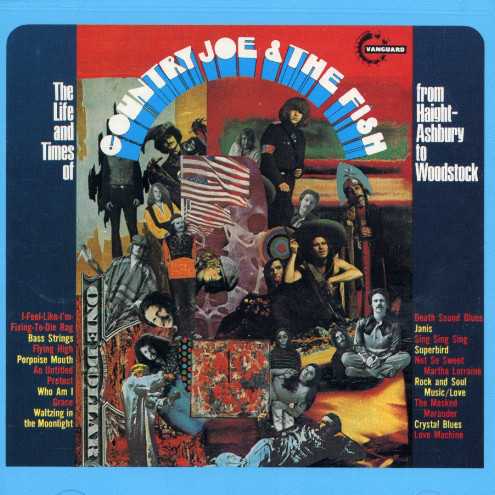 | Album: 1 of 8 Title: The Life and Times of Country Joe & The Fish Released: Tracks: 19 Duration: 1:17:10 Scroll: Up Down Top Bottom 25% 50% 75% Allmusic AlbumCover | 1 I-Feel-Like-I’m-Fixin’-To-Die Rag (03:46) 2 Bass Strings (03:58) 3 Flying High (02:41) 4 Porpoise Mouth (02:51) 5 An Untitled Protest (02:46) 6 Who Am I (04:07) 7 Grace (07:03) 8 Waltzing in the Moonlight (02:16) 9 Death Sound Blues (04:25) 10 Janis (02:39) 11 Sing Sing Sing (03:04) 12 Superbird (Tricky Dick) (05:26) 13 Not So Sweet Martha Lorraine (04:05) 14 Marijuana (02:34) 15 Rock and Soul Music/Love (06:19) 16 Crystal Blues (05:18) 17 Masked Marauder (04:11) 18 Love Machine (06:11) 19 The “Fish” Cheer/I-Feel-Like-I’m-Fixin’-To-Die Rag (03:24) |
| The Life and Times of Country Joe & The Fish : Allmusic album Review : This 77-minute CD is close to an ideal compilation, reaching back to before the bands beginnings for the original 1965 recording of "I-Feel-Like-Im-Fixin-to-Die Rag" and across seven of the better cuts off of Electric Music for the Mind and Body, up through the Woodstock Festival and the bands farewell concert that same year at the Fillmore West. It reels in most of the notable album cuts in between, all in surprisingly good sound (not usually a strong point on Vanguard CDs of the late 80s). The 19 songs, which dont follow a strict chronological order, encompass some of the bands most celebrated experimental material, as well as more traditionally structured songs such as the fiery double-lead guitar workout "Death Sound Blues," the catchy, folk-rock-style "Sing Sing Sing," and the counterculture singalong "Marijuana" and works of serious personal significance (and intimately focused genius), including "Grace" and "Janis." The disc offers a good balance between the various sides of the groups sound and includes several notable live tracks, including the November 1968 Fillmore East performance of "Superbird," an anti-Lyndon Johnson song that dated back to 1965 and which is adapted here to include an attack on president-elect Richard Nixon. The sound is amazingly good and consistent throughout, and the track order, as well as the music itself, is downright spellbinding at times; the annotation is minimal, but this CD really has only a single flaw -- apparently, between the 1965 original version of "I-Feel-Like-Im-Fixin-to-Die Rag" and the 1969 Woodstock performance, there was no room for the standard studio version off of the bands second LP. | ||
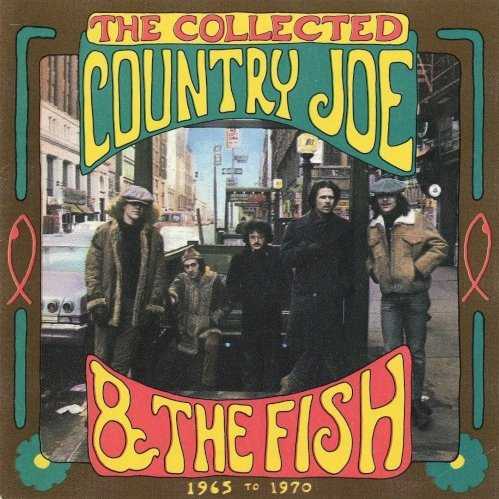 | Album: 2 of 8 Title: The Collected Country Joe and the Fish (1965 to 1970) Released: Tracks: 19 Duration: 1:11:56 Scroll: Up Down Top Bottom 25% 50% 75% AlbumCover | 1 Superbird (03:10) 2 Bass Strings (03:58) 3 Section 43 (06:45) 4 Flying High (02:41) 5 Not So Sweet Martha Lorraine (04:24) 6 Death Sound Blues (04:25) 7 Porpoise Mouth (02:51) 8 Sad and Lonely Times (02:26) 9 The "Fish" Cheer / I-Feel-Like-Im-Fixin-To-Die Rag (03:43) 10 Rock Coast Blues (03:42) 11 Janis (02:39) 12 Eastern Jam (04:23) 13 Good Guys / Bad Guys Cheer (00:43) 14 Rock and Soul Music (06:46) 15 An Untitled Protest (02:46) 16 Here I Go Again (03:28) 17 Maria (03:34) 18 Crystal Blues (05:46) 19 Rockin Round the World (03:37) |
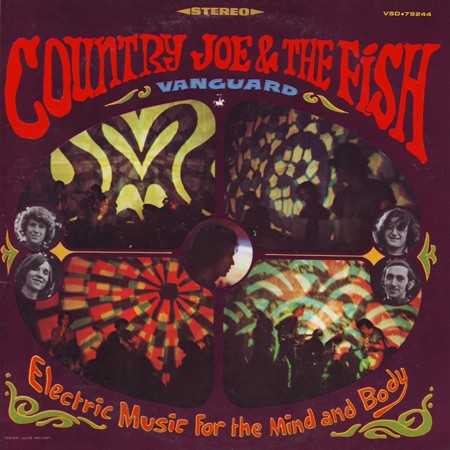 | Album: 3 of 8 Title: Electric Music for the Mind and Body Released: 1967-04 Tracks: 11 Duration: 44:03 Scroll: Up Down Top Bottom 25% 50% 75% Spotify Allmusic AlbumCover | 1 Flying High (02:41) 2 Not So Sweet Martha Lorraine (04:24) 3 Death Sound (04:26) 4 Porpoise Mouth (02:51) 5 Section 43 (07:26) 6 Super Bird (02:07) 7 Sad and Lonely Times (02:26) 8 Love (02:24) 9 Bass Strings (05:03) 10 The Masked Marauder (03:12) 11 Grace (07:03) |
| Electric Music for the Mind and Body : Allmusic album Review : Their full-length debut is their most joyous and cohesive statement and one of the most important and enduring documents of the psychedelic era, the bands swirl of distorted guitar and organ at its most inventive. In contrast to Jefferson Airplane, who were at their best working within conventional song structures, and the Grateful Dead, who hadnt quite yet figured out how to transpose their music to the recording studio, Country Joe & the Fish delivered a fully formed, uncompromising, and yet utterly accessible -- in fact, often delightfully witty -- body of psychedelic music the first time out. Ranging in mood from good-timey to downright apocalyptic, it embraced all of the facets of the bands music, which were startling in their diversity: soaring guitar and keyboard excursions ("Flying High," "Section 43," "Bass Strings," "The Masked Marauder"), the groups folk roots ("Sad and Lonely Times"), McDonalds personal ode to Grace Slick ("Grace"), and their in-your-face politics ("Superbird"). Hardly any band since the Beatles had ever come up with such a perfect and perfectly bold introduction to who and what they were, and the results -- given the prodigious talents and wide-ranging orientation of this group -- mightve scared off most major record labels. Additionally, this is one of the best-performed records of its period, most of it so bracing and exciting that one gets some of the intensity of a live performance. The CD reissue also has the virtue of being one of the best analog-to-digital transfers ever issued on one of Vanguard Records classic albums, with startlingly vivid stereo separation and a close, intimate sound. | ||
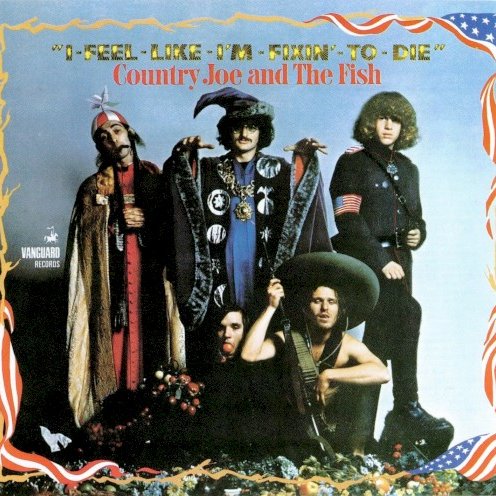 | Album: 4 of 8 Title: I-Feel-Like-Im-Fixin-To-Die Released: 1967-11 Tracks: 10 Duration: 45:01 Scroll: Up Down Top Bottom 25% 50% 75% Spotify Allmusic Wikipedia AlbumCover | 1 The Fish Cheer / I-Feel-Like-Im-Fixin-To-Die Rag (03:43) 2 Who Am I (04:05) 3 Pats Song (05:25) 4 Rock Coast Blues (03:57) 5 Magoo (04:43) 6 Janis (02:36) 7 Thought Dream (06:39) 8 Thursday (03:19) 9 Eastern Jam (04:30) 10 Colors for Susan (05:59) |
| I-Feel-Like-I'm-Fixin'-To-Die : Allmusic album Review : Country Joe & the Fishs second album, "I-Feel-Like-Im-Fixin-To-Die", is quite similar to their first in its organ-heavy psychedelia with Eastern-influenced melodic lines, but markedly inferior to the debut, and much more of a period piece. Theres more spaciness and less comic energy here, and while the bandmembers were undoubtedly serious in their explorations, some of these songs are simply silly in their cosmic naïveté. To be crueler, there is no other album that exemplifies so strongly the kind of San Francisco psychedelia that Frank Zappa skewered on his classic Were Only in It for the Money. The weeping, minor-key melodies, liquid guitar lines, and earnestly self-absorbed quests to explore the inner psyche -- its almost as if they put themselves up as a dartboard for the Mothers to savage. For all that, the best songs are good; "Who Am I" and "Thursday" are touching psychedelic ballads. But more notably, the title cut -- whose brash energy is atypical of the album -- was a classic antiwar satire that became one of the decades most famous protest songs, and the groups most famous track. | ||
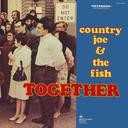 | Album: 5 of 8 Title: Together Released: 1968 Tracks: 11 Duration: 34:58 Scroll: Up Down Top Bottom 25% 50% 75% Spotify Allmusic AlbumCover | 1 Rock and Soul Music (06:54) 2 Susan (03:31) 3 Mojo Navigator (02:27) 4 Bright Suburban Mr. & Mrs. Clean Machine (02:22) 5 Good Guys/Bad Guys Cheer and The Streets of Your Town (03:42) 6 The Fish Moan (00:28) 7 The Harlem Song (04:23) 8 Waltzing in the Moonlight (02:16) 9 Away Bounce My Bubbles (02:28) 10 Cetacean (03:41) 11 An Untitled Protest (02:46) |
| Together : Allmusic album Review : Together, Country Joe & the Fishs third album, was the groups most consistent, most democratic, and their best-selling record. Unlike their first two albums, which were dominated by Country Joe McDonalds voice and compositions, Together featured the rest of the band -- guitarists Barry Melton and David Cohen, bassist Bruce Barthol, and drummer Chicken Hirsh -- almost as prominently as McDonald. Thats usually a formula for disaster, but in this case it gave the album more variety and depth: McDonald tended to favor droning mantras like the album-closing "An Untitled Protest," which worked better when contrasted with the likes of Meltons catchy anti-New York diatribe, "The Streets of Your Town," and the group-written "Rock and Soul Music." Songs like the latter cast the group as a soul revue, true, and they couldnt quite pull that off, but Together had the charming quality of unpredictability; you never knew what was coming next. Unfortunately, what came next in the bands career was a split. Barthol was out by September 1968, Cohen and Hirsh followed in January 1969. Thereafter, McDonald and Melton fronted various Fish aggregations, but it was never the same, even when this lineup regrouped for Reunion in 1977. | ||
 | Album: 6 of 8 Title: Here We Are Again Released: 1969 Tracks: 10 Duration: 36:57 Scroll: Up Down Top Bottom 25% 50% 75% Spotify Allmusic AlbumCover | 1 Here I Go Again (03:28) 2 Donovans Reef (04:22) 3 Its So Nice to Have Love (03:29) 4 Baby, Youre Driving Me Crazy (02:47) 5 Crystal Blues (06:23) 6 For No Reason (04:00) 7 Ill Survive (02:33) 8 Maria (03:34) 9 My Girl (02:22) 10 Doctor of Electricity (03:59) |
| Here We Are Again : Allmusic album Review : By the time of Country Joe & the Fishs fourth album, the group seemed to consist of only Joe McDonald and Barry Melton, who had started the band in the beginning. Here We Are Again continued CJ&Fs move toward pop (especially on "Here I Go Again") and bluesy rock, and away from their folk and jug band beginnings. But there were no songs to match some of the idiosyncratic winners on earlier albums, and the anonymous studio backing lacked the spontaneity of the original Fish. Though there would be one more new album in 1970 (C J Fish), Country Joe & the Fish no longer existed as anything other than a name; a fact that would be underlined in December 1969 by the simultaneous releases of Greatest Hits and McDonalds solo album, Thinking of Woody Guthrie. | ||
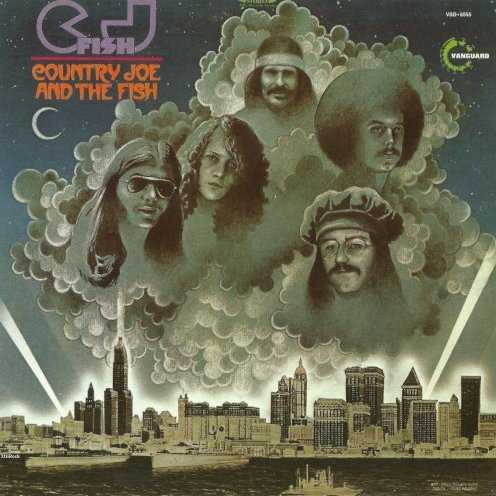 | Album: 7 of 8 Title: C.J. Fish Released: 1970 Tracks: 11 Duration: 40:11 Scroll: Up Down Top Bottom 25% 50% 75% Spotify AlbumCover | 1 Sing Sing Sing (03:05) 2 Shes A Bird (04:38) 3 Mara (03:01) 4 Hang On (04:12) 5 The Baby Song (02:55) 6 Hey Bobby (02:11) 7 Silver And Gold (02:47) 8 Rockin Round The World (04:54) 9 The Love Machine (05:48) 10 The Return Of Sweet Lorraine (03:50) 11 Hand Of Man (02:50) |
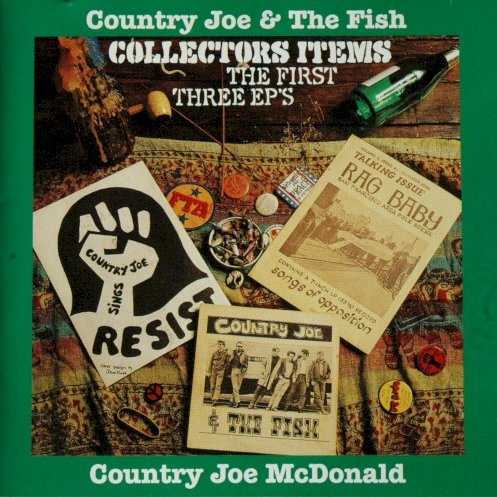 | Album: 8 of 8 Title: Collectors Items (The First Three EPs) Released: 1994-10-25 Tracks: 14 Duration: 00:00 Scroll: Up Down Top Bottom 25% 50% 75% Allmusic AlbumCover | 1 Who Am I? (?) 2 Dirty Claus Rag (?) 3 I Feel Like Im Fixin To Die Rag [Take 1] (?) 4 Superbird (?) 5 (Thing Called) Love (?) 6 Bass Strings (?) 7 Section 43 (?) 8 I Feel Like Im Fixin To Die Rag [Edited Version][Edit][Take] (?) 9 Fire In The City (?) 10 Johnnys Gone In The War (?) 11 Kiss My Ass (?) 12 Tricky Dicky (?) 13 Free Some Day (?) 14 I Feel Like Im Fixin To Die Rag [Alternate Edited ...][#][Take] (?) |
| Collector's Items (The First Three EPs) : Allmusic album Review : Prior to signing with Vanguard Records in 1967, Country Joe McDonald and his group, the Fish, had already recorded two low-budget EPs as "talking versions" of McDonalds self-realized magazine Rag Baby -- a Bay Area adaptation of the folk magazine Broadside. Collectors Items: The First Three EPs is a single CD that compiles the highly collectable 7" records that allowed Country Joe & the Fish national attention via the underground "head shops" that stocked Rag Baby. Performing on the first of these extended-play singles was a primordial version of Country Joe & the Fish. McDonald (vocals/guitar) and his close musical associate, Barry Melton (vocals/guitars), are augmented by Carl Shrager (washboard), Bill Steel (bass), and Mike Beardslee (vocals/guitar). Their decidedly jug band instrumentation and delivery is a clear indicator of the folky roots that were strikingly similar to that of other burgeoning bands in the Bay Area, such as Mother McCrees Uptown Jug Champions, who would soon morph into the Grateful Dead. The A-side of the disc included two Country Joe & the Fish tunes: "I Feel Like Im Fixin to Die Rag" and "Superbird." In addition to the released version of "I Feel Like Im Fixin to Die Rag," which is listed here as take one and includes some fairly disconcerting machine-gun and mortar sound effects, are alternates that contain the infamous "F-U-C-K" Woodstock chant -- listed as take two -- as well as the more familiar version that would be included as the title track of their Vanguard debut. On the B-side of this first extended-play 7" single was a folksinger/songwriter named Peter Krug whose contributions to the disc were equally as apocalyptic as Country Joe & the Fish in content. Krugs compositions include "Fire in the City," which was also covered by jazz vocalist Jon Hendricks and a then-virtually unknown backup band who had just changed their name from the Warlocks to the Grateful Dead, as well as the more conventional "Johnnys Gone to War." In contrast to the band featured on the Country Joe & the Fish sides, Krugs tracks are much more traditionally arranged and feature a simple acoustic guitar accompaniment. The second EP debuts the electric incarnation of the band and solidified the existence of Rag Baby magazine as well as Country Joe & the Fish the amplified psychedelic rock band. Side A is composed of "(Thing Called) Love" and "Bass Strings," two relatively short performances at under four minutes apiece. Allowing themselves the freedom to stretch out in a style and delivery more akin to their public performances, "Section 43" clocks in at nearly seven minutes. It would be another two years before the Beatles would release a longer single with "Hey Jude." All three of these tunes would be reworked on their second long-player, Electric Music for the Mind and Body. The final EP was cut by McDonald and a band credited as "Groonta." It is mix of acoustic ("Kiss My Ass"/"Tricky Dicky") and electric ("Free Some Day") tunes and was recorded for the express purpose of being sold for a dollar and 50 cents at the infamous Free the Army political and musical review that included such notables as Jane Fonda and Donald Sutherland. The show toured underground coffee houses in 1971 and McDonald cut this disc in support of and for sale at these performances. | ||